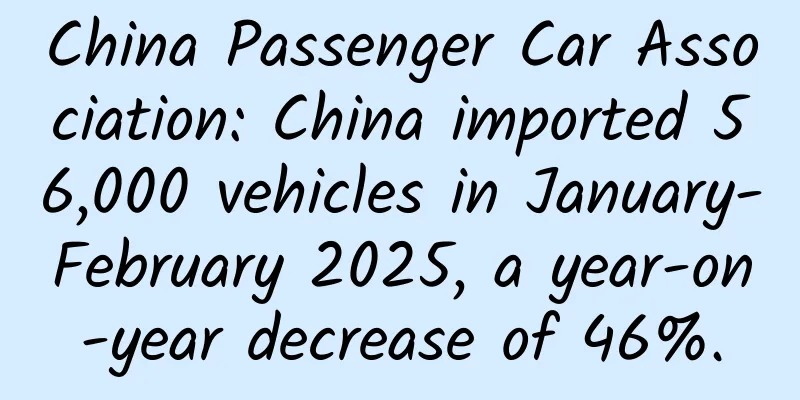China Passenger Car Association: China imported 56,000 vehicles in January-February 2025, a year-on-year decrease of 46%.

|
Cui Dongshu, secretary general of the China Passenger Car Association, said that China's imports of cars have continued to decline at an average annual rate of about 8% from 1.24 million in 2017 to only 800,000 in 2023. In 2024, car imports will reach 700,000, a year-on-year decrease of 12%. At present, 56,000 cars were imported in January-February 2025, a year-on-year decrease of 46%. The pressure of continued shrinkage of imported cars is relatively large. With the rise of domestic cars and the acceleration of localization of international brands, car imports have continued to be sluggish in recent years, with negative growth for three consecutive years from January to December. The top 10 countries with the highest imports in January-February 2025 are: Germany 16,867 vehicles, Japan 13,014 vehicles, Slovakia 11,248 vehicles, the United States 6,543 vehicles, the United Kingdom 4,434 vehicles, Sweden 1,018 vehicles, Mexico 971 vehicles, Austria 538 vehicles, South Korea 218 vehicles, and Hungary 202 vehicles. The largest increase in January-February compared with January-February last year was in Slovakia, with 1,530 vehicles. From January to December 2024, the countries with the highest number of imported cars are Japan (227,987), Germany (192,817), the United States (109,842), Slovakia (62,412), the United Kingdom (45,096), Sweden (22,311), Austria (10,790), Mexico (8,253), Hungary (8,063), and South Korea (4,773). Cui Dongshu pointed out that as China's auto industry continues to grow stronger, the electrification transformation has changed the market demand structure, the demand for fuel vehicles has continued to shrink, and the demand for imported fuel vehicles has also declined significantly. As international relations become increasingly complex, we still need to prepare for the rainy day and establish more complex import models to maintain a reasonable scale of imported vehicles. 1. Overall trend of China's automobile imports 1. Characteristics of the growth rate of automobile imports After reaching a peak of 1.43 million vehicles in 2014, the import growth rate declined. In 2016-2017, the import growth rate stabilized and improved slightly, but has continued to decline since 2018. In 2023, the import scale dropped sharply, with only 800,000 vehicles imported for the whole year, a year-on-year decrease of 10%. In 2024, the import scale dropped sharply, with only 700,000 vehicles imported for the whole year, a year-on-year decrease of 12%. At present, 56,000 vehicles were imported in January-February 2025, a year-on-year decrease of 46%, and the pressure of continued shrinkage of imported vehicles is relatively large. In January-February 2025, 56,000 vehicles were imported, down 46% year-on-year and 56% month-on-month from November-December last year. This is a rare huge decline in January-February. In 2024, 700,000 vehicles were imported, down 12% year-on-year. With the rise of domestic cars and the acceleration of localization of international brands, car imports have continued to be sluggish in recent years, with negative growth in imported cars for three consecutive years. If the fluctuations are smoothed out, it will be seven consecutive years of negative growth. International relations have been complicated recently, and the scale of imported vehicles will be increased in July-August 2024 to prevent risks. The impact of overdrafts was still reflected at the beginning of this year. 2. Monthly trend of vehicle imports The first half of 2024 showed a normal seasonal trend, especially in June-August when imports recovered well. As the expectation of import tariffs was not met, there was a sharp decline from September to November, and high-end consumption was under great pressure. Many dealers were waiting for the tax increase to clear their stocks. The sales volume fell dramatically at the beginning of the year, mainly because they waited and saw the downgrade this year, and stabilized after February. 3. Structural characteristics of imported complete vehicles The import car market was relatively stable from 2017 to 2019. Since 2022, all types of models have declined across the board. Traditional trucks were imported in large quantities in 2023, and are now falling rapidly. New energy heavy trucks have replaced imported heavy trucks and become a new growth point. In 2025, the import of passenger cars will be less than demand, and the import volume will recover. This year, passenger cars account for 98% of the absolute dominant position in the automobile import structure. Among them, 24,000 sedans were imported in January-February 2025, accounting for 42%; 17,000 four-wheel drive SUVs were imported, accounting for 30%; and 7,000 unlisted motor vehicles of new energy vehicles were imported, accounting for 1%. The performance of commercial vehicle imports in 2024 was average, especially the import of light trucks in 2023, but tractors and medium trucks were not strong. The recent import of pickup trucks is also weak. Passenger car imports account for 98% of automobile imports. If pickup trucks are included in light trucks, the proportion of passenger cars is even higher. This year, the import of cars has declined across the board, and the demand for trendy toys is not very good. 4. Structural characteristics of new energy vehicle imports In recent years, the import of new energy passenger cars has achieved sustained high growth, but it has fallen sharply in 2024. From January to February 2025, 691 pure electric passenger cars were imported, a decrease of 89%; 579 plug-in hybrid cars were imported, a decrease of 81%. The performance of imported new energy passenger cars is relatively weak. The market for traditional fuel imported passenger cars has declined significantly, the share of diesel vehicles in trucks has rebounded, while the share of gasoline trucks has decreased, which is related to the demand for tractors. The import performance of high-end gasoline pickup trucks in 2025 is slow. Recently, the domestic new energy commercial vehicle market has performed relatively strongly, and the imported pure electric pickup truck market has also performed relatively poorly. In 2024, the proportion of new energy vehicles imported into China will reach 3%, and in January-February 2025, the proportion of new energy vehicles imported into China will drop to 2%. Pure electric vehicles will drop slightly compared with last year, and fuel passenger vehicles will still be the absolute main force. The proportion of gasoline vehicles in trucks is still relatively high, but diesel vehicles have improved significantly. 5. Characteristics of the displacement structure of imported passenger vehicles The displacement of imported passenger cars is concentrated in gasoline models below 2 liters, and the 3-4 liters have better resistance to price drops. The displacement of imported passenger cars was originally concentrated in gasoline models below 2 liters, accounting for 46% of the total gasoline vehicle imports in January-February 2025, a decrease of 7 percentage points from last year. The decline in high-end large-displacement models is slower. In recent years, the sales of imported large-displacement cars of 2.5-3 liters have declined slowly, and their share has increased. Since the models in the domestic market are mainly below 2 liters, there is less competitive pressure from imported 2.5-3 liters. II. Automobile Import Market Structure 1. Import characteristics by country China's passenger car importing countries are still mainly Germany, Japan, Slovakia and the United States, and imports from Slovakia have increased significantly recently. 2. Monthly trend of vehicle imports Imported cars are under great pressure to decline in January and February. The top 10 countries with the highest imports in January and February 2025 are: Germany 16,867 vehicles, Japan 13,014 vehicles, Slovakia 11,248 vehicles, the United States 6,543 vehicles, the United Kingdom 4,434 vehicles, Sweden 1,018 vehicles, Mexico 971 vehicles, Austria 538 vehicles, South Korea 218 vehicles, and Hungary 202 vehicles. The largest increase in January and February compared with January and February last year was in Slovakia, with 1,530 vehicles. The countries with the highest number of imported cars in 2024 are Japan (227,987 vehicles), Germany (192,817 vehicles), the United States (109,842 vehicles), Slovakia (62,412 vehicles), the United Kingdom (45,096 vehicles), Sweden (22,311 vehicles), Austria (10,790 vehicles), Mexico (8,253 vehicles), Hungary (8,063 vehicles), and South Korea (4,773 vehicles). 3. Characteristics of countries importing new energy vehicles The import volume of new energy vehicles was large before 2019, but the decline in pure electric vehicles caused by Tesla's domestic production in 2021 was large. In 2021, pure electric vehicles saw a significant decline due to the impact of Tesla's domestic production, but the development of new energy was very good in 2022-2023, allowing more companies to import new energy. In 2024, domestically produced cars will be more competitive, and the import of new energy vehicles from major importing countries will drop by half. The pressure on imported new energy passenger vehicles will increase further this year. 3. Automobile Market Sales Volume 1. Overall sales volume of imported vehicles Due to the strength of China's independent automakers, the sales performance of imported cars continued to deteriorate, and was also weaker than the trend of the domestic luxury car market. In 2021, the sales of imported cars reached 940,000 units, a 6% decrease from 2020. In 2022, the sales volume of imported cars reached 840,000 units, which was 10% lower than that of 2021 and relatively weaker than the performance of domestic cars. In 2023, the sales volume finally returned to positive growth, reaching 910,000 units, an increase of 8%. From January to December 2024, the compulsory traffic insurance data for imported vehicles was 800,000, a year-on-year decrease of 12%. Due to the high base at the beginning of 2024, the retail sales of imported vehicles declined significantly from January to February this year, and the pressure in the future will remain high. In previous years, the import volume of imported cars maintained a high level of nearly 100,000 units in January, but this year the sales trend of imported cars has fallen sharply. This is related to the sharp rebound in imported car retail sales at the end of 2024. The Spring Festival factor led to weak demand in January and slow recovery in February. Imports may be more cautious in the future. 2. Characteristics of imported car brands Imports of ultra-luxury cars have continued to grow in the past few years, but have fallen by 12% since 2023, accelerating to 46% in 2024 and 31% in January-February 2025. Bentley and Rolls-Royce have performed relatively well, and although they have continued to decline, their sales are still at a relatively high level. The overall trend of Maserati is sluggish, and the overall trend of ultra-luxury is weak, reflecting the temporary slowdown in the purchasing power of ultra-high-end consumer groups, but high-end Ferrari performed very well in January-February 2025. At present, the demand for imported cars is mainly supported by luxury cars, and non-luxury imported cars have shrunk dramatically. The proportion of main imported luxury cars has increased significantly. Lexus's import retail sales in 2025 fell by 6%, which is a good performance. BMW, Audi, and Land Rover have generally performed well, while Porsche's recent performance has been weak. The import volume of joint venture brands is shrinking rapidly, and the import volume of some brands such as Toyota, Volkswagen, and Subaru is shrinking sharply. 3. Regional changes in imported super luxury car brands The demand for imported cars is generally weak, and the imported super luxury car market in traditional wealthy areas such as Shanghai, Shenzhen, Beijing and Chengdu is under great pressure. New energy vehicles have little impact on super luxury cars. The wealthy want to show their status, and Ferrari and other cars are still performing well. Due to the special business and identity characteristics of super luxury cars, the overall market demand is not good. 4. Regional changes in luxury car market The overall demand for domestic and imported luxury cars is weak, and the luxury car market in traditional wealthy regions such as Shanghai, Shenzhen, Beijing, and Chongqing is under great pressure. This year, Suzhou and Chongqing performed generally. |
<<: Realme X review: Redmi killer or cheap Reno?
Recommend
The success of Jiang Xiaobai’s marketing does not only rely on copywriting!
Friends who work in operations and write copy sho...
New battery technology emerges: iPhone battery life is expected to increase by 3 times
What is your wish for the new generation of iPhone...
Stockings were originally designed for men! Why are they so tempting? Here comes the serious science popularization
Expert of this article: Zhao Wei, Doctor of Medic...
QuestMobile: AI large model applications will grow rapidly in 2024, DeepSeek's monthly active users will reach 180 million
With the continuous upgrading of AI big models, d...
Special planning of the "How Much Do You Know About Nutrition" series | One article explains everything related to high-quality protein
What is protein? Amino acids are the basic units ...
4 common misunderstandings in short video operations, how many of them have you encountered?
According to the conventional short video operati...
How much does it cost to inject hyaluronic acid into the nose? Chongqing SEO website promotion is not popular, how to make spiders favor it
When it comes to SEO optimization, we will find t...
How to create a WeChat vegetable selling mini program in Foshan? How to sell vegetables through WeChat mini program?
Today's industries are diverse, and many new ...
Intel Launches New SoC Solution to Dramatically Reduce Costs and Accelerate Electric Vehicle Innovation
Innovative OLEA U310 SoC simplifies motor technol...
How to analyze the 4 characteristics of online hot spots through user psychology
With the Internet so developed today, every hot s...
Planning introduction: numerical design starts from these three aspects
[[150172]] Numerical design is actually born for ...
How to write a title? 7 steps, from conception to hit product
How did you come up with the title? Do you receiv...
A simple introduction to coroutines, threads and concurrency issues
"Coroutines are lightweight threads", I...
Wu Feng's "From English Basics to Interpretation Experts" 2021 Edition
: : : : : : : : : : : : : : : : : : : : : : : : : ...
ColorOS 11 based on Android 11 officially announced: released on September 24
Following the launch of Android 11 Beta1 version ...









